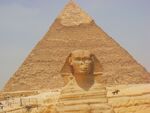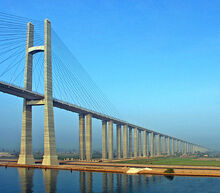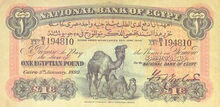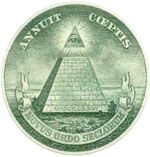| Arab Republic of Egypt جمهورية مصر العربية (Arabic) | |||||
|---|---|---|---|---|---|
| |||||

| |||||
| Capital | |||||
| Languages | |||||
| Demonym |
Egyptian | ||||
| Currency |
Egyptian pound (EGP) | ||||
| Establishment | |||||
|
c. 3100 BC | |||||
|
-Independence from the United Kindom |
February 28, 1922 | ||||
|
June 18, 1953 | |||||
|
March 30, 2011 | |||||
| GDP (PPP) | |||||
| -Total |
$508.265 billion (2011) | ||||
| -Per capita |
$6,361 (2011) | ||||
| GDP (nominal) | |||||
| -Total |
$231.111 billion (2011) | ||||
| -Per capita |
$2,892 (2011) | ||||
| v · d · e | |||||
| This article contains special characters. Without proper rendering support, you may see question marks, boxes, or other symbols |
Egypt ( /ˈiːdʒɪpt/ (help • info); مصر, Miṣr Arabic: [mesˤɾ]; Egyptian Arabic: [mɑsˤɾ]; Coptic: Ⲭⲏⲙⲓ Kīmi), officially known as the Arab Republic of Egypt is a modern country located in North Africa and Southeast Asia, thus being a transcontinental country. It is bordered by Libya to the west, Israel to the east, and Sudan to the south.
The economy of Egypt is one of the most diversified of all the countries in the Middle East, with sectors including tourism, agriculture, industry, and service at almost equal production levels.
Etymology[]
The English name Egypt was borrowed from Middle French Egypte, from the Latin word Aegyptus, from Ancient Greek Aígyptos (Αἴγυπτος), from the earlier Linear B 𐁁𐀓𐀠𐀴𐀍 a-ku-pi-ti-yo. The adjective aigýpti-, aigýptios was borrowed into the Coptic language as ⲅⲩⲡϯⲓⲟⲥ/ⲕⲩⲡϯⲓⲟⲥ gyptios, kyptios, and from there into the Arabic language as قبطي qubṭī, back formed into قبة qubṭ, whence English Copt. The Greek forms of the word were borrowed from Late Egyptian (Amarna) Hikuptah "Memphis", a change of the earlier Egyptian name Hwt-ka-Ptah (ḥwt-kꜣ-ptḥ), which translates into "home of the ka (soul) of Ptah", the name of a temple to the god Ptah at Memphis.[1] Strabo credited the word to a folk etymology in which the word Aígyptos (Αἴγυπτος) evolved as a combination of Aigaiou huptiōs (Aἰγαίου ὑπτίως), which translates into "below the Aegan". Miṣr, the Arabic and modern official name of Egypt (Egyptian Arabic: Maṣr) comes from Semitic origins, being directly cognate with other Semitic words for Egypt, such as Hebrew מִצְרַיִם (Mitzráyim), meaning "the two straits" (a reference to the dynastic separation of upper and lower Egypt).[2] The original word connoted "metropolis" or "civilization" and means "country", or "frontier-land".
The Ancient Egyptian name is Kemet [𓆎𓅓𓏏𓊖], meaning "black land", referring to the dark-colored fertile soils of the Nile flood plains, in comparison to the deshret, or "red land" of the desert.[3] It is realized as kīmi and kīmə in the Coptic stage of Egyptian, and appeared in Early Greek as Χημία (Khēmía).[4] An alternate name was tꜣ-mry, meaning "land of the riverbank".[5] The names of Upper and Lower Egypt were Ta-Sheme'aw (tꜣ-šmꜥw) "sedgeland" and Ta-Mehew (tꜣ mḥw) "northland".
History[]

The Great Sphinx and Pyramid of Khafre in Egypt.
There is a significant amount of evidence to suggest that people first settled in Ancient Egypt during the 10th millennium BC; however, it wasn't until 3100 BC that a unified state was developed. From this time over the next three millennia, a series of dynasties ruled over the land of Egypt. Afterward, Egypt became part of the Achaemenid Empire and then the Ptolemaic Kingdom, Roman Empire, and Byzantine Empire. After the Greco-Roman rule in Egypt ended, a number of Muslim caliphates and sultanates were formed in northeastern Africa and portions of Asia, including portions of Egypt. These ruled the country until 1517, when the Ottoman Empire established a province in the area, known as the Egypt Eyalet, and later, the Khedivate of Egypt. The Sultanate of Egypt, administered as a British protectorate, was established in 1914, which was followed by the Kingdom of Egypt, the Republic of Egypt, the United Arab Republic, and finally modern-day Egypt.
On March 30, 2011, Egypt developed a new constitution following a series of protests against then-President Hosni Mubarak.
Economy[]
- For more information, see Economy of Egypt
Egypt's economy is mainly dependent on agriculture, media, petroleum exports, and tourism; currently, there are over three million Egyptians working in foreign countries, mainly in Saudi Arabia, around the Persian Gulf, and Europe. An estimated 2.7 million of these workers contribute actively to the development of Egypt via remittances (US$ 7.8 billion in 2009), as well as circulation of human and social capital and investment. In 1970, the completion of the Aswan High Dam and the resultant Lake Nasser have dramatically changed the amount of land near the Nile River for agriculture and ecology. A rapidly changing population, along with little arable land and dependence on the Nile are all contributing to overtaxing resources and stressing the economy.[6]

The Suez Canal Bridge.
The government of Egypt has invested its money in communications and physical infrastructure. Egypt has received foreign aid from the United States (since 1979, an average of $2.2 billion per year), being the third largest recipient of these funds, followed by the Iraq War. The main revenues of Egypt, however, are from tourism as well as the traffic going through the Suez Canal.
Egypt has created its own energy market which is based on coal, oil, natural gas, and hydraulics. Substantial deposits of coal are found in the northeast Sinai and are mined at a rate of approximately 600,000 metric tons (590,000 LT; 660,000 ST) yearly. Oil and gas, however, are produced in the western desert, the Gulf of Suez, and the Nile Delta. Egypt has massive reserves of gas, at an estimated 470 cubic miles (1940 km³), and transports liquified natural gas to many countries.
Economic conditions in Egypt have considerably begun to improve after a period of inactivity from the adoption of more liberal economic policies by the government as well as the increased revenues coming from tourism and a booming stock market. In its yearly report, the International Monetary Fund, or IMF, has rated Egypt as one of the top countries in the world undertaking economic reform.[7] Some important economic reforms taken by the Egyptian government since 2003 include a major slashing of customs and tariffs. A new taxation law carried out in 2005 decreased corporate taxes from 40% to 20%, resulting in a proposed 100% increase in tax revenue by 2006.

Tourists ride in a traditional Nile boat across the river.
Foreign Direct Investment, or FDI, into Egypt has considerably increased during the past few years, reaching more than $6 billion in 2006, as a result of recent economic liberalization measures taken by Mahmoud Mohieddin, Egypt's minister of investment.
Though one of the main obstacles faced by the Egyptian economy is the trickle down of the wealth to the average population, several residents of Egypt criticize the government for the higher prices of basic goods while their standards of living or purchasing power stays lacking progress. Corruption is often considered by the residents is the main obstruction to further economic growth.[8][9][10] The government has promised major reconstruction of infrastructure in Egypt, using the money paid for the new third mobile license ($3 billion) by the Emirates Telecommunications Corporation of the United Arab Emirates.[11]
The most noted multinational companies from Egypt are the Orascom Group and Raya Contact Center. Over the past few years, the IT sector has expanded rapidly, with many start-ups selling outsourcing services to North American and European countries, operating with companies including Microsoft, Oracle, and other major corporations as well as small and medium enterprises. Some of these smaller enterprises are the Xceed Contact Center, Raya, E Group Connections, and C3. The IT sector has since been stimulated by new Egyptian entrepreneurs with encouragement by the government.
Numismatics[]

The first Egyptian pound note.
One of the first coins minted in modern-day Egypt was a gold stater from the reign of Pharaoh Nectanebo II. At the time, the area was part of the Achaemenid Empire, which introduced a currency system comprising of darics and sigloi. Portions of the Achaemenid Empire, including part of Egypt, were annexed to Macedonia by Alexander the Great, introducing the drachma to the area. After Alexander's death, Egypt began to be ruled by the Ptolemaic Kingdom, which introduced its coinage in the area, which were the only coins permitted to be circulated in Egypt.
Around 30 BC, after Egypt was incorporated into the Roman Empire as Ægyptus, Roman coins began to circulate. It later became part of the Byzantine Empire, and Byzantine solidi and nummi began to be produced at the newly reopened Alexandria Mint, under leadership by Emperor Justin I. The Persians took control of Egypt between 617 and 628, and in 1640 Muslim forces led by Umar entered Egypt. Despite this, Byzantine coins continued to circulate in the area, until coins bearing Christian inscriptions and depictions of Jesus Christ began to circulate. As a result, the Muslim rulers of Egypt began to issue their own dinar and dirhem coins, which bore Islamic inscriptions. Coins of this fashion were struck by the Abbasids, Tulunids, Fatimids, Ayyubids, and Mamluks from around 711 to 1517.
In 1517, after the fall of the Mamluk Sultanate, the Ottoman Empire took control of Egypt. During this time, the Egyptians developed a piastre currency based on the then-circulating currency of the Ottoman Empire. The currently circulating currency of Egypt, the pound, was introduced in 1834, under leadership by Caliph Mahmud II.
| Code | Currency Name | Dates | Conversion | Divisions | |||
|---|---|---|---|---|---|---|---|
| Egyptian piastre |
|
several; 40 para = 1 piastre | |||||
| EGP | Egyptian pound |
|
100 piastres = 1 pound |
Egypt on foreign currency[]

The Seal of the United States on a dollar bill.
The reverse of the Great Seal of the United States features an Egyptian pyramid with the Eye of Providence floating above. It comprises 13 layers, which refer to the thirteen original colonies. The pyramid represents strength and duration. The seal is located on the reverse of the U.S. dollar bill. A similar pyramid, designed by Francis Hopkinson, was used on the Continental 50 dollar banknote.[12][13]
In 1970, to mark the 10th anniversary of its independence, Chad issued commemorative 200 and 10,000 franc coins which featured Egyptian president Gamal Abder Nasser.
In 1997, Gibraltar issued two commemorative coins, with the topic of the evolution of mankind, which featured ancient Egyptian people, the pyramids, and hieroglyphics. Also during that year, the Isle of Man issued a 1 pound coin commemorating the history of the cat, which featured an Egyptian goddess on its reverse.
Other countries and territories that have referenced Egypt on coins include the British Virgin Islands, Cuba, Dominica, and the Saharawi Arab Democratic Republic.
References[]
|
| Africa | |
|---|---|
| Countries | Algeria • Angola • Benin • Botswana • Burkina Faso • Burundi • Cameroon • Cape Verde • Central African Republic • Chad • Comoros • Democratic Republic of the Congo • Republic of the Congo • Côte d'Ivoire • Djibouti • Egypt • Equatorial Guinea • Eritrea • Ethiopia • Gabon • Gambia • Ghana • Guinea • Guinea-Bissau • Kenya • Lesotho • Liberia • Libya • Madagascar • Malawi • Mali • Mauritania • Mauritius • Morocco • Mozambique • Namibia • Niger • Nigeria • Rwanda • São Tomé and Príncipe • Senegal • Seychelles • Sierra Leone • Somalia • South Africa • South Sudan • Sudan • Swaziland • Tanzania • Togo • Tunisia • Uganda • Zambia • Zimbabwe |
| Unrecognized countries | Somaliland • Sahrawi Arab Democratic Republic (Western Sahara) |
| Non-sovereign territories | Ascension • Canary Islands • Ceuta • French Southern and Antarctic Lands* • Madeira • Mayotte • Melilla • Plazas de soberanía • Réunion • Saint Helena • Tristan da Cunha |


